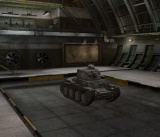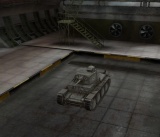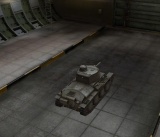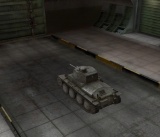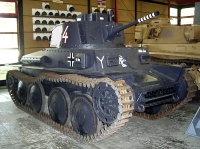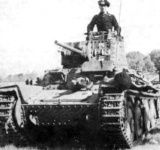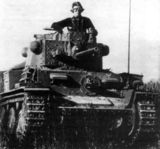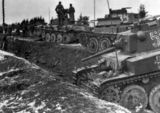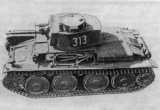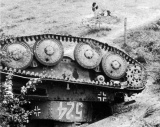Pz.Kpfw. 38 (t)
| Revision as of 06:03, 20 March 2012 | Revision as of 15:50, 21 March 2012 Removed outside pics links | |||
| Line 36: | Line 36: | |||
| }} | }} | |||
| {{Panel Gallery|Historical Gallery| | {{Panel Gallery|Historical Gallery| | |||
| ? | + | [[File:Pan38ad.jpg|160px|Pan38ad.jpg]] | ||
| ? | + | [[File:PzKpfw_38(t)_pic2.jpg|160px|PzKpfw_38(t)_pic2.jpg]] | ||
| ? | + | [[File:PzKpfw_38(t)_pic1.jpg|160px|PzKpfw_38(t)_pic1.jpg]] | ||
| ? | + | [[File:Pz38(t)_22d.jpg|160px|Pz38(t)_22d.jpg]] | ||
| ? | + | [[File:Pz38(t)_36d.jpg|160px|Pz38(t)_36d.jpg]] | ||
| ? | + | [[File:Pz38(t)_37d.jpg|160px|Pz38(t)_37d.jpg]] | ||
| ? | + | |||
| ? | + | |||
| ? | + | |||
| ? | + | |||
| ? | + | |||
| }} | }} | |||
| {{Panel content|style=collapsed|title=Sources and External Links|content= | {{Panel content|style=collapsed|title=Sources and External Links|content= | |||
Revision as of 15:50, 21 March 2012
The PzKpfw 38 (t) is a German tier 3 light tank. It is not that different to its predecessor, the PzKpfw 35 (t). It does offer increased top speed and mounts a more powerful gun, but sacrifices traverse speed and has 1mm less armor on the sides and rear.
- The PzKpfw 38 (t) leads to the PzKpfw 38 nA.
G08 Pz38t/ModulesG08 Pz38t/EquipmentG08 Pz38t/Consumables
Historical Info
The LT(Light Tank) vz.(model) 38 was destined to become one of the most widely used Czechoslovakian tanks, although not in Czechoslovak hands. Ordered into production in 1938, the LT-38 drew on the experience from the earlier LT-35 and became the most successful product of the Czechoslovakian industry. LT-38s in different variants was exported to many countries and gained an excellent reputation among its foreign users such as Sweden (THN Sv), Iran / Persia (TNH), Peru (LTP), Switzerland (LTH - Pz39), and Lithuania (LTL).
On March 23rd of 1939, CKD (Ceskomoravska Kolben Danek) delivered single LT-38 tanks to the Royal Armored Corps’ Gunnery School at Lulworth for demonstration, with hopes of selling tanks to the RAC. The demonstration was concluded with a report that stated the following: "On the whole, the machine is almost equivalent to our cruiser tanks, but little experience or experiment has gone into the design of the fighting compartment, and performance has been obtained at the expense of the crew and general fight-ability." The report largely critized the LT-38 and the RAC did not purchase any tanks from CKD.
The 1938/39, German take-over of the Czechoslovakian state led to the confiscation of 150 LT-38s in production in March 1939, and CKD/Praga was ordered to complete them all. All of them were incorporated into the German Army as the PzKpfw 38 (t) Ausf A - Sd.Kfz.140. After the German take-over of Czechoslovakia, the LT-38 became one of the most important tanks used by the Panzertruppe and was retained in production as a tank until June of 1942. During the war, PzKpfw 38 (t)s were exported and saw service with German Allies including: Romania (50), Slovakia (90), Bulgaria (10), and Hungary (102). The PzKpfw 38 (t) also saw service with the Allies. A single tank was captured by the British and French in May / June 1940. Another example (turret number 543) was captured either during the Italian Campaign in 1943 or Normandy in 1944 and was tested in England. Numbers of PzKpfw 38 (t)s were captured and pressed into service by the Red Army. A number of PzKpfw 38 (t)s in service with the Slovak Army participated in the Slovak national uprising in August of 1944. Finally, in May of 1945, the PzKpfw 38 (t), now known as the LT-38/37 (37 standing for 37mm gun,) was back in service with the Czechoslovakian Army as a training tank until the early 1950s.
PzKpfw 38 (t)
Approximately 1400 PzKpfw 38 (t)s were produced in 8 different variants (Ausf A/B/C/D/E/F/S/G) with various modifications, improved armor protection, and armed with Czech-made 37mm Skoda A7 vz.38 guns designated by the Germans as 37mm KwK 38(t) L/48 (L/47.8). It is interesting to note that Ausf Ss were vehicles purchased by Sweden, but impounded by the Germans in the Spring of 1940. Instead, Germans granted Scania-Vabis licence and production rights, who in turn produced the Strv m/41. The early model's construction was riveted (and a direct hit on its armor plate could tear rivet heads off and kill or wound the crew), while the later model's construction was largely welded. Later on, earlier models were up-armored and a few were possibly rearmed with the German-made 37mm KwK 35/36 L/46.5 gun, but it is unconfirmed.
A number were also converted to flamerthrower tanks by replacing the hull machine gun with a flamethrower, while fuel was supplied from a towed single-axle trailer carrying 200 liters of fuel by a hose. There was also the PzKpfw 38 (t) swimming tank with a prototype AP-1 float, but it never entered production.
Further production of the PzKpfw 38 (t)’s chassis continued with improved models of Ausf H/K/L/M, which were used as a base for various vehicles (such as the Marder III Ausf H/M, Bison/Grille Ausf H/K/M, and Hetzer). In addition, older models returned for repair were often used as a base for a conversion.
PzKpfw 38 (t)s were built under German supervision and saw extensive service in Poland (3rd Leichte Division), Norway (XXXI Armee Korps), France (6th, 7th and 8th Panzer Division), Balkans (8th Panzer Division), and Russia (6th, 7th, 8th, 12th, 19th and 20th Panzer Division). During the fighting in Russia, the need for heavier armor and armament made the PzKpfw 38 (t) inadequate and in 1942, it was relegated to other duties (e.g. reconnaissance and service in armored trains).
In September of 1939, plans were laid for the development of a fast/light reconnaissance tank and in early 1942, 15 PzKpfw 38 (t) nAs (neuer Art) were produced by BMM (Praga/CKD), but its design was not accepted for production. In 1942, the usual German process of adapting the chassis for other purposes commenced with vehicles such as the Marder III and Flakpanzer 38(t). In 1942 and 1943, a number of PzKpfw 38 (t)s had their turrets removed and were converted to driver training vehicles that, late in the war, were mounted with wood-burning generators. Training vehicles based on turret-less tanks were designated as PzKpfw 38 (t) Schulfahrwannes and were used by school units of the Wehrmacht and NSKK. Some 351 PzKpfw 38 (t) turrets were used for German fortifications in Norway (75), Denmark (20), Western Atlantic shore (9), Italy (25), Southwest Europe (150), and the Eastern Europe/Front (78).
One of the most interesting conversions was the Aufklärungspanzer 38 (t) - Sd.Kfz.141/1. They were used as reconnaissance vehicles fitted with the "Hangelafette" turret (20mm KwK 38 L/55 gun and MG42 - used in armored cars) or armed with the 75mm KwK 37 L/24 (and MG42) gun mounted in the modified superstructure. Only 50 to 70 Aufklarungspanzer 38(t)s armed with the 20mm gun were built from late 1943 to early 1944, and only 2 Aufklarungspanzer 38(t)s, armed with 75mm gun, were built in 1944.
